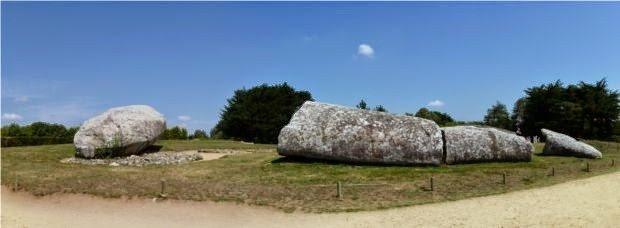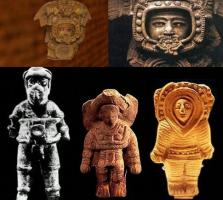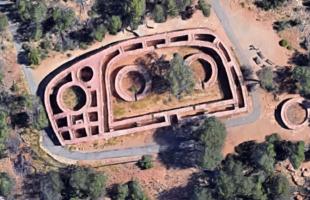Why did our ancestors erect menhirs?
About 7 thousand years ago, our ancestors began to erect majestic megalithic monuments called Menhirs. Widely distributed in Europe, Africa and Asia, these structures are most numerous in Western Europe, particularly in Brittany and the British Isles. They were erected in many different periods throughout prehistory and were created in the context of the so-called megalithic culture that flourished in and around Europe. But why?


Researchers make the rise of the European Megalithic Culture coincide with the appearance of the first communities born from the fusion of the European groups of hunter-gatherers with the first farmers from the Near East. With the new energy guaranteed by the multiplication of food resources, our ancestors created something truly extraordinary: the first large stone monuments.
With the erection of these great megalithic structures, researchers associate the development of the first reflections on the relationship between matter and spirit and on the meaning of life and death.
The European region richest in megalithic structures is certainly the Gulf of Morbihan, in southern Brittany. This place offers very important evidence of that era: dozens and dozens of sites with thousands of megaliths, some of which are even decorated.
Megaliths were widespread in many other parts of Europe, but what is striking is the extent of the sites. They range from Sweden to Ireland, from Portugal to Italy, from Great Britain to France, and even North Africa.
Some researchers have suggested that Europe was first united by the megalith tradition, and indeed it could be considered the first major religion spread on a large scale across the continent.
Even today, the ability of our primitive ancestors to raise these enormous complexes is surprising. The most famous is certainly the Stonehenge site, the result of centuries of additions and alterations. The idea that these complexes were used for the precise observation of the stars and the movement of the sun is very widespread.
Many have proposed alternative theories on the origins of the monuments, even invoking the intervention of extraterrestrials. Yet, one remains disconcerted when one thinks that illiterate societies, which did not know the wheel or metals, were capable of creating masterpieces that still leave one breathless today. What techniques were used to raise such megalithic monuments is still a matter of speculation.
The Menhirs
Menhirs (from the Breton men and hir "long stone") are monolithic megaliths usually erected during the Neolithic period, which could reach more than twenty meters in height. They are widely distributed in Europe, Africa and Asia, but are most numerous in Western Europe, particularly in Brittany and the British Isles.
They could be erected individually or in groups, and with dimensions that can vary considerably, although their shape is generally square, sometimes tapering towards the top.
At the famous site of Carnac, located in the Morbihan department in the Brittany region, 3 thousand Menhirs have been counted. Built around 6 thousand years ago, the Menhirs of Carnac seem to compose a real stone army, over a kilometer long and arranged in several rows.

The rocky material from which the Carnac menhirs were taken is light granite, a particularly hard stone to work. Once the megalith had been chosen, it had to be transported to the chosen and raised site. The problem is that very often this was many kilometers away. How did they do it, if our ancestors didn't know the wheel?
Some have speculated that the builders slid the huge rocks on wooden rollers, smearing a natural lubricant such as animal fat. Of course, human strength was behind it all: it really took a lot of people.
According to the researchers, these techniques were also enough to erect one of the most colossal Menhirs known: the Great Broken Menhir of Locmariaquer (Morbihan). Today it is on the ground, broken into four enormous blocks, but at the time it was 21 meters long.

Buried for 3 meters, the Menhir stood 18 meters high, as high as a six-story building, and weighed 280 tons. And he wasn't the only one: there were 18 others positioned in a row, aligned in decreasing order. The largest remained standing for centuries, only to be knocked down by the same Neolithic men. The reason for the destruction is shrouded in mystery.
Important sites with menhirs are also found in Italy. In Sardinia, for example, where menhirs take the name of "perdas fittas" or "pedras fittas" (imbedded stones), they are present in Laconi and Villa Sant'Antonio, in the province of Oristano, but also in Goni and Sant'Antioco, in the province of Cagliari. Important sites are also found in Puglia, Liguria, Piedmont and Lombardy.
Why?
Why such physical and intellectual effort? What was the meaning of these immense structures? In reality, we don't know. Some speculate that each of the boulders could represent an important ancestor, a deceased leader, or a hero from the past, the equivalent of statues of emperors and saints.
If true, Neolithic megalithic sites would represent the history of our ancestors, complete with dynasties, heroes and legendary figures. But, unfortunately, we know nothing about them. At that time, in fact, writing had not yet been invented and therefore there are no written documents and engraved steles that tell chronicles and events: these are chapters of history lost into oblivion.
These megalithic populations raised megaliths for twenty centuries in a row. Then, they began to abandon them and no longer erect them. The reasons are unclear. Whatever the reason, around 5 thousand years ago, the tradition of megaliths died out across Europe: the era of the stone giants was over forever.



























